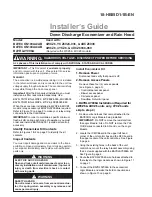
3
1. Safety precautions
• For installation and relocation work, follow the instructions in the installation
manual and use tools and pipe components specifically made for using with
refrigerant specified in the outdoor unit installation manual.
• If the air conditioner is installed in a small room or closed room, measures
must be taken to prevent the refrigerant concentration in the room from
exceeding the safety limit in the event of refrigerant leakage. Should the
refrigerant leak and cause the concentration limit to be exceeded, hazards
due to lack of oxygen in the room may result.
Caution:
• Perform grounding.
Do not connect the ground wire to a gas pipe, water pipe arrester or
telephone ground wire. Defective grounding could cause an electric shock.
• Do not install the unit in a place where an inflammable gas leaks.
If gas leaks and accumulates in the area surrounding the unit, it could cause
an explosion.
• Install a ground leakage breaker depending on the installation place (where it
is humid).
If a ground leakage breaker is not installed, it could cause an electric shock.
• Perform the drainage/piping work securely according to the installation
manual.
If there is a defect in the drainage/piping work, water could drop from the unit
and household goods could be wet and damaged.
• Fasten a flare nut with a torque wrench as specified in this manual.
When fastened too tight, a flare nut may broken after a long period and cause
a leakage of refrigerant.
2. Selecting the installation location
2.1. Indoor unit
• Where airflow is not blocked.
• Where cool air spreads over the entire room.
• Where it is not exposed to direct sunshine.
• At a distance 1 m or more away from your TV and radio (to prevent picture from
being distorted or noise from being generated).
• In a place as far away as possible from fluorescent and incandescent lights (so the
infrared remote control can operate the air conditioner normally).
• Where the air filter can be removed and replaced easily.
Warning:
Mount the indoor unit into a ceiling strong enough to withstand the weight of
the unit.
2.2. Outdoor unit
• Where it is not exposed to strong wind.
• Where airflow is good and dustless.
• Where it is not exposed to rain and direct sunshine.
• Where neighbours are not annoyed by operation sound or hot air.
• Where rigid wall or support is available to prevent the increase of operation sound
or vibration.
• Where there is no risk of combustible gas leakage.
• When installing the unit at a high level, be sure to fix the unit legs.
• Where it is at least 3 m away from the antenna of TV set or radio. (Otherwise,
images would be disturbed or noise would be generated.)
• Install the unit horizontally.
Caution:
Avoid the following places for installation where air conditioner trouble is
liable to occur.
• Where there is too much machine oil.
• Salty environment as seaside areas.
• Hot-spring areas.
• Where sulfide gas exists.
• Other special atmospheric areas.
3. Selecting an installation site & Accessories
• Select a site with sturdy fixed surface sufficiently durable against the weight of unit.
• Before installing unit, the routing to carry in unit to the installation site should be
determined.
• Select a site where the unit is not affected by entering air.
• Select a site where the flow of supply and return air is not blocked.
• Select a site where refrigerant piping can easily be led to the outside.
• Select a site which allows the supply air to be distributed fully in room.
• Do not install unit at a site with oil splashing or steam in much quantity.
• Do not install unit at a site where combustible gas may generate, flow in, stagnate
or leak.
• Do not install unit at a site where equipment generating high frequency waves (a
high frequency wave welder for example) is provided.
• Do not install unit at a site where fire detector is located at the supply air side. (Fire
detector may operate erroneously due to the heated air supplied during heating
operation.)
• When special chemical product may scatter around such as site chemical plants
and hospitals, full investigation is required before installing unit. (The plastic
components may be damaged depending on the chemical product applied.)
• If the unit is run for long hours when the air above the ceiling is at high temperature/
high humidity (due point above 26 °C), due condensation may be produced in the
indoor unit. When operating the units in this condition, add insulation material (10-
20 mm) to the entire surface of the indoor unit to avoid due condensation.
3.1. Install the indoor unit on a ceiling strong enough
to sustain its weight
Secure enough access space to allow for the maintenance, inspection, and
replacement of the motor, fan, drain pump, heat exchanger, and electric box in one
of the following ways.
Select an installation site for the indoor unit so that its maintenance access space will
not be obstructed by beams or other objects.
(1) When a space of 500 mm or more is available below the unit between the unit
and the ceiling (Fig. 3-1-1)
• Create access door 1 and 2 as shown in Fig. 3-1-2.
(2) When a space of less than 500 mm is available below the unit between the unit
and the ceiling (At least 20 mm of space should be left below the unit as shown in
Fig. 3-1-3.)
• Create access door 1 diagonally below the electric box and access door 3
below the unit as shown in Fig. 3-1-4.
WT09638X02.book 3 ページ 2020年10月6日 火曜日 午後4時8分




































